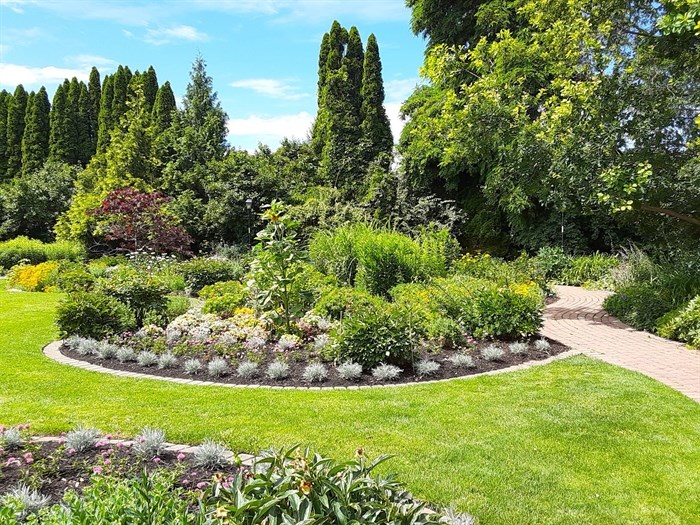
The gardens are in bloom at Guisachan Park in Kelowna.
Image Credit: SUBMITTED/ Colleen Jill Herman
July 14, 2024 - 6:00 AM
Two Kelowna cyclists took a slight detour off their main route last week and stumbled upon a gorgeous park with a fascinating history tucked between buildings in Kelowna’s South Pandosy neighbourhood.
“We bike there all the time but we never went down Cameron Street, it’s only a block away and who knew there’s a park tucked behind the buildings we were passing,” said Colleen Jill Herman.
Colleen and her husband Christopher discovered Guisachan Park in Kelowna in late June and wandered through the gardens under the shade trees there where a flower festival and wedding were taking place.
“There are lush flower beds everywhere, it’d be a fabulous place for wedding photography,” Colleen said.
She was intrigued by the property and the house located at 1060 Cameron Avenue and looked up its history.
The land was once an enormous ranch, but in the early 1890s it was purchased by Lord Aberdeen, who was the Governor General of Canada at the time, according to the City of Kelowna.
The single-storey Guisachan House was built in 1891 with wood siding in a Victorian style.
Guisachan means Place of the Fir in Gaelic, and was named after Lady Aberdeen’s childhood home in the Scotland.
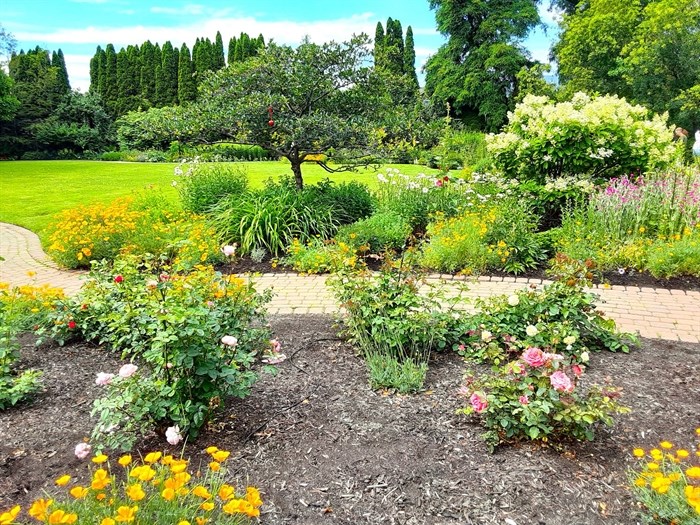
Guisachan Park in Kelowna has beautiful gardens to stroll through.
Image Credit: SUBMITTED/ Colleen Jill Herman
The Aberdeens planted 200 acres of orchards during their time at Guisachan. The ranch was later sold to a former sea captain and who sold it to W.C. Cameron in 1903.
Cameron grew fruit and hay on the land and after he died his sons operated the ranch growing mixed crops and livestock.
“I was intrigued by the history, now I understand where Cameron Street got its name from, it’s neat to see where local names come from,” Colleen said.
The sons split the acreage and livestock in the 1920s, with one of them, Paddy Cameron, taking the piece with the house on it and moving into dairy cattle, eventually operating a retail dairy store and then moving to the beef cattle industry before retiring in 1965. Cameron sold most of the land but kept a lease on the house and seven acres.
After he died, Okanagan Historical Society took over the house for public use and it became a park. Today, the house is Guisachan House Restaurant which is surrounded by two acres of landscaping and gardens. The property has heritage status and significance as a rare colonial bungalow in the city.
“We’re planning to take a few different routes this summer, try out new roads to see what other gems we can find,” Colleen said.
READ MORE: What to do if you see a pet in a hot car in Okanagan, Kamloops
Another park to check out is Munson’s Pond Park located in the centre of Kelowna near the intersection of Benvoulin Road and KLO roads. The natural park is 24 acres in size and is home to Munson Pond, an ecological treasure surrounded by cottonwood trees.
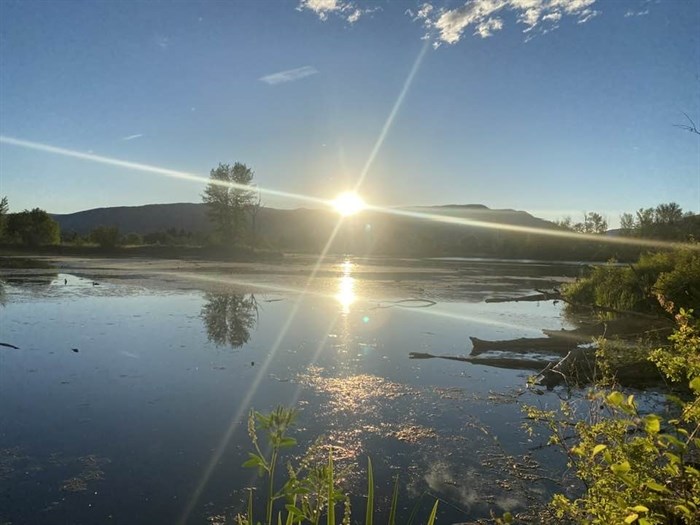
The sun rises over Munson Pond in Kelowna in June.
Image Credit: SUBMITTED/ Alan Cohoe
The pond is named after the Munson family who were pioneer farmers in the area from the early 1890s, according to the City of Kelowna website.
It started as a gravel pit in the 1960s and after it was abandoned it was filled up by the area’s high water table and has been a popular spot for bird watching ever since.
Kelowna resident Alan Cohoe spends much of his free time at the pond, watching wildlife.
“It has so much bird and wildlife activity, it’s pretty neat to see this in the middle of a city,” he said in a previous interview with iNFOnews.ca. “Right now, wild mock orange trees are in full bloom and the fragrance is incredible. The water table will drop right now and when it gets hot it’s not as vibrant, the ducks go to other ponds, but there is always something going on.”
READ MORE: Non-profit opposed to new suburb proposal in Kelowna’s north-end
The Old Men’s Cemetery on 6 Avenue in Kamloops is in a small well-manicured park shaded by numerous varietals of deciduous trees, and full of fascinating local lore.
The park holds the remains of more than 1,000 men who once lived at the Provincial Old Men’s Home, an establishment for the poor and indigent, former miners, fur traders and guides that was built in 1895.
During that time there was a large population of single old men with almost twice as many males as females living in the province, and for many of the men there was no retirement and pensions did not exist yet.
In 1893, the provincial government passed an act to establish a provincial home for the aged and infirm. Just two years later, in September of 1895, the home opened in Kamloops.
READ MORE: Penticton councillor putting plan together to address aggressive urban deer problem
In 1922, a cemetery was created for the men on a site below where St. Andrews church now stands. The home closed in 1974, the same year the last person to be interred there died and today a senior’s home sits on the site.
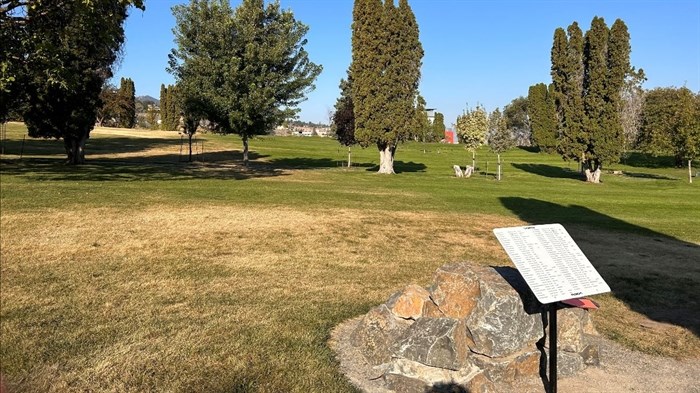
Cairn in the Old Men's Provincial Cemetery
Image Credit: Submitted by City of Kamloops
Ground penetrating radar was used to locate the remains in 2020 and local historians worked to provide information on the men.
Visitors to the park can stroll the walkways through the trees and read plaques of the men who are buried there, the provinces they came from and their occupations.
Another small Kamloops park full of history is the Chinese Cemetery tucked away next to Guerin Creek in the city’s West End, which is the resting place for many of the community’s earliest settlers.
It is also a remnant of Kamloops’ historic Chinatown, a once bustling community which made up roughly one-third of the city’s population in 1890.
READ MORE: iN PHOTOS: Muddy backyard near Kamloops transforms into xeriscape masterpiece
Grave markers were accidentally removed in the late 1970s, but a decade ago Kamloops resident Elsie Cheung worked to gather as much information as could to find the lost names.
The buried now have their names, age and jobs listed nearby, on plaques Cheung and the Kamloops Chinese Freemason Association installed at the cemetery’s gazebo, instead of on the tombstones.
While the Chinese Cemetery has fewer shade trees, it has a beautiful view and a lot of history to learn while strolling through the grounds.
Have you found lesser known parks in your neck of the woods? Let us know at news@infonews.ca.
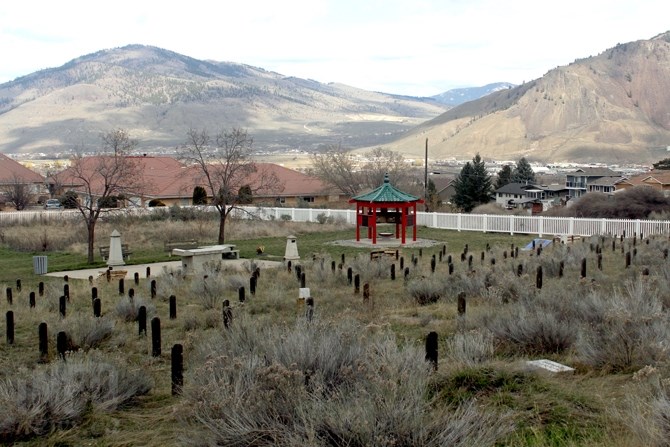
Looking northeast from the Chinese Cemetery in Kamloops.
(BRENDAN KERGIN / iNFOnews.ca)
To contact a reporter for this story, email Shannon Ainslie or call 250-819-6089 or email the editor. You can also submit photos, videos or news tips to the newsroom and be entered to win a monthly prize draw.
We welcome your comments and opinions on our stories but play nice. We won't censor or delete comments unless they contain off-topic statements or links, unnecessary vulgarity, false facts, spam or obviously fake profiles. If you have any concerns about what you see in comments, email the editor in the link above. SUBSCRIBE to our awesome newsletter here.
News from © iNFOnews, 2024